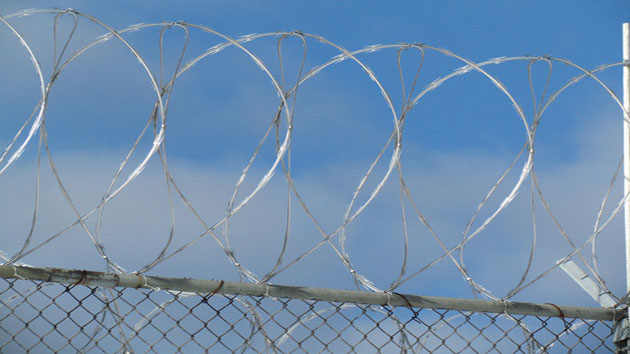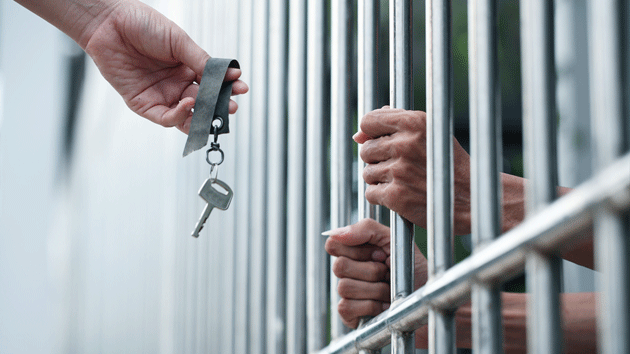
<a href="https://www.flickr.com/photos/katerha/6771698125/in/photolist-bjoHVX-6qoBmK-de3U-6qsN9C-dLFf89-g9giVA-6ypZ8K-2wDtw2-eb3LNR-ayMkd1-aBgfi7-5weRaZ-kBxd2-7PBNhi-5Us16p-ajfM3h-bBi4mF-781dTA-d8CnT5-5bprAc-MAwA3-eb9jd1-d8CqWs-nSvDgi-nU82wz-bQLeQ8-7PBNmR-68E4nZ-p5WsJk-m7gM9V-7PFM3J-eNkwbA-6bNPGm-4xHtMJ-eNkw9o-bNLGdz-bNLFPa-4xX7Gp-9sWd2M-7PBNk8-dV5BnG-89H6wj-juNbnz-9hWi2A-7PBNiV-28caBX-bNLEeB-eb3Mb8-eb3Msn-eb9p6J">Kate Ter Haar</a>/Flickr
This story first appeared on the TomDispatch website.
On January 27th, domestic violence survivor Marissa Alexander will walk out of Florida’s Duval County jail—but she won’t be free.
Alexander, whose case has gained some notoriety, endured three years of jail time and a year of house arrest while fighting off a prison sentence that would have seen her incarcerated for the rest of her life —all for firing a warning shot that injured no one to fend off her abusive husband. Like many black women before her, Alexander was framed as a perpetrator in a clear case of self-defense. In November, as her trial date drew close, Alexander accepted a plea deal that will likely give her credit for time served, requiring her to spend “just” 65 more days in jail. Media coverage of the development suggested that Alexander would soon have her “freedom,” that she would be “coming home.”
Many accounts of the plea deal, however, missed what Alexander will be coming home to: she’ll return to “home detention”—house arrest—for two years.
In other words, an electronic monitor, secured around her ankle at all times, will track her every movement. Alexander will also be paying $105 per week to the state in monitoring fees, as is the custom in Florida and more than a dozen other states.
Such a situation is certainly preferable to being caged in a prison cell. However, does Alexander’s release—and that of others in her shoes—mean freedom? In reality, an ever-growing number of cages are proliferating around us, even if they assume forms that look nothing like our standard idea of a cage.
As mass incarceration is falling out of fashion—it’s been denounced by figures across the political spectrum from Eric Holder to Newt Gingrich—a whole slate of “alternatives to incarceration” has arisen. From electronic monitoring and debilitating forms of probation to mandatory drug testing and the sort of “predictive policing” that turns communities of color into open-air prisons, these alternatives are regularly presented as necessary “reforms” for a broken system.
It’s worth remembering, however, that when the modern prison emerged in the late eighteenth century, it, too, was promoted as a “reform,” a positive replacement for corporal or capital punishment. Early prison reformers—many of them Quakers bent on repentance and redemption—suggested that cutting people off from the rest of the world would bring them closer to God. (The word “penitentiary” comes, of course, from “penitence.”)
An oppressive version of surveillance played a central role in this vision, as in British reformer Jeremy Bentham’s famed Panopticon, a model prison in which inspectors would be able to view prisoners at any moment, day or night, while themselves remaining invisible. If the ultimate Panopticon never quite came into existence, Bentham’s idea profoundly influenced the development of the prison as a place in which, for the prisoner, no time or space was inviolable and privacy was a fiction.
As an idea, the Panopticon remains embedded in our notion of state discipline. Now, it is spreading out of the prison and into the neighborhood and the home, which is hardly surprising in a society in which surveillance and monitoring are becoming the accepted norms of everyday life. Like the plans of the early reformers, many current prison “reforms” share a common element: they perpetuate the fantasy that new forms of confinement, isolation, and surveillance will somehow set us all free.
At first glance, these alternatives may seem like a “win-win.” Instead of taking place in a hellish institution, prison happens “in the comfort of your own home” (the ultimate American ad for anything). However, this change threatens to transform the very definition of “home” into one in which privacy, and possibly “comfort” as well, are subtracted from the equation. Perhaps the best example is the electronic monitor, an imprisonment device that is attached to the body at all times.
Electronic Monitoring
House arrest has long been used to quell political resistance. By confining people to their homes, repressive governments are able to weaken an oppositional figure’s ties to the world, while allowing the authorities to know where the confined person is at every moment. From St. Paul to the deposed pro-democracy Iranian president Mohammad Mosaddegh, Galileo to Burma’s Aung San Suu Kyi, dissidents and nonconformists have long watched their homes become their prisons.
However, the rise of new technologies—in particular, electronic monitoring—has allowed the practice of home confinement to become widespread. Nowadays, if you’re under house arrest, there are no longer armed guards circling the premises. Instead, the “guards” are satellites, their gaze always present, and they don’t even blink.
Appropriately enough, electronic monitoring was introduced in 1984. Since then, it has been used for an ever-expanding range of purposes, including pretrial confinement, parole, and probation, or simply as a punishment in and of itself. Monitoring has put new populations under state control, expanding the range of people who are confined in this country. According to an analysis in the Journal of Law and Policy, most of those placed on electronic monitors haven’t committed serious or violent offenses and, were it not for monitoring, “at least some of these populations would not in fact be incarcerated or otherwise under physical control.”
In prison, the loss of one’s civil liberties is glaringly apparent. The strip search, the cell sweep, and the surveillance of letters, phone calls, and visits are givens. For those whose homes have been “prisonized,” however, basic constitutional rights also crumble. Probationers and monitorees are subject to warrantless searches and drug tests; probation officers have ready access to their homes. In fact, though seldom thought of this way, the ankle monitor is essentially a constant, warrantless search.
As research scholar James Kilgore notes, for those being monitored, “the default position in most instances is house arrest” and therefore they’re often more restricted than their counterparts in jails and prisons. Incarcerated people have daily quotas for calories and are usually granted a certain amount of outdoor exercise time (however miserable the food or outdoor facilities may be). Under house arrest, neither of those protections apply. Similarly, prisoners are usually granted the right to access legal materials; this guarantee is not a given for monitored people.
Even probation officers have acknowledged how monitoring—both the actual physical confinement and the constant knowledge of being watched—seeps into each moment of a confined person’s daily life. A Department of Justice study, for example, found that, with the visible ankle monitor acting as a “scarlet letter,” those permitted to go to work had a difficult time finding or holding jobs. That’s a problem in itself, since it’s well known that gaining employment is a crucial step in avoiding future offenses. Full-scale house arrest, however, locks people into a life of stasis and boredom, inhibiting their ability to connect with loved ones or form new bonds—crucial factors in building a sustainable life.
Eighty-nine percent of probation officers surveyed by the Justice Department felt that “offenders’ relationships with their significant others changed because of being monitored.” Both officers and those monitored observed that the ankle band had a distinct impact on children. As one parent testified, “When it beeps, the kids worry about whether the probation officer is coming to take me to jail. The kids run for it when it beeps.” Another noted that his child repeatedly strapped a watch around his ankle “to be like Daddy.”
Beyond the physical and emotional burdens, those under monitoring often pay for their confinement in the most literal possible fashion. As Marissa Alexander discovered in Florida, private companies often exact fees from the people they’re imprisoning. They average around $10-$15 per day—in addition to installation costs and fees imposed for drug tests or other “services.” Those unable to pay may be re-incarcerated in a cycle that harkens back to debtor’s prison.
By the end of her sentence, Alexander will have spent $16,420 on her own imprisonment and constant surveillance.
Probation and Drug Testing
You don’t, however, have to be hooked up to a fancy monitoring device to find yourself paying for your confinement. As probation is increasingly contracted out to private companies—in Georgia, for example, 40% of probation services are privatized—many non-monitored probationers are subject to steep fees and failure to pay such probation costs might also result in jail time.
This phenomenon, dubbed “offender-funded probation” has recently become ever more popular. A 2014 report by Human Rights Watch revealed that 1,000 courts in at least 12 states now employ it in a twisted mix of budget-tightening, privatization, and corporatization. As author and organizer Kay Whitlock writes, “This industry is built upon disdain for poor and low-income people, and a determination that their wretchedly limited resources should not only support the illusion of administration of justice but simultaneously provide private business owners and courts with new revenue.”
With nearly four million people on probation in this country, what an increasingly “offender-funded” system would look like is coming into focus: state coffers would be filled with dollars from those with the most meager resources, while the threat of debtor’s prison would hang over the heads of those who don’t or simply can’t comply. In addition, despite their rhetoric about “correction” and “rehabilitation,” for-profit enterprises are actually driven by the distinctly for-profit urge to keep people in the system, while bringing in ever more of them.
In addition to monitoring and probation, mandated drug tests are another standard item that can be turned into a cash cow. Most people ensnared in the criminal justice system (whether incarcerated or on supervised release) are required to undergo regular drug testing, regardless of whether their offense is drug-related. Companies now charge about $25 per test, meaning that a person serving a year-long probation sentence is likely to be saddled with a $1,250 drug-testing bill.
 Moreover, drug testing is helping to expand the criminal system into new areas of society. Thanks to decades of drug-war policies, the tests have entered schools, hospitals, workplaces, and the welfare system—and testing positive can result in serious punishment, including surveillance and confinement. One in five high schools now use drug tests and many punish a “dirty drop” with loss of extracurricular activities or even expulsion from school.
Moreover, drug testing is helping to expand the criminal system into new areas of society. Thanks to decades of drug-war policies, the tests have entered schools, hospitals, workplaces, and the welfare system—and testing positive can result in serious punishment, including surveillance and confinement. One in five high schools now use drug tests and many punish a “dirty drop” with loss of extracurricular activities or even expulsion from school.
As the Fifth Circuit Court of Appeals noted decades ago, “there are few activities in our society more personal or private than the passing of urine.” Yet in many circumstances, from workplaces to law enforcement probation visits, people being tested are not only listened to, but also watched as they urinate. The Minnesota Department of Corrections, for instance, gives these instructions to its probation and parole staff: “Staff must… position himself/herself in such a manner as to verify the specimen passes directly from the offender’s body into the specimen collection container.”
Such drug tests are also used by child protective services agencies during home visits to surveil parents, overwhelmingly mothers of color and particularly black mothers. A failed drug test may result in the removal of children from the home—regardless of whether the drug use is affecting the parenting abilities of the user.
During the drug-war years, unlike the other ways in which we relate to our bodies and our health, drug use has become fair game for policing and state surveillance. No state intervention can mandate that you stop eating gluten or quit smoking cigarettes or undergo chemotherapy, but we have come to accept the idea that outside authorities may monitor, control, and punish your choice to use certain drugs—and rampant drug testing is a graphic manifestation of that. Like any health-related blood or urine test, drug testing is not inherently bad, but its widespread, mandatory, and invasive deployment by the state is unique among health procedures. It is the only routine medical test that can land you in jail.
As public approval of drug-war-fueled mass incarceration ebbs, however, it’s important to remember that the drug “battlefield” now extends well beyond the prison and that privacy violations once reserved for jails and drug treatment centers are now common in places where privacy was once a given.
Predictive Policing
Perhaps the most prevalent prison-outside-of-prison version of incarceration happens before, not after, arrest. It’s what anti-police-violence activist Joseph “Jazz” Hayden calls “open-air prisons“—that is, the intensification of policing and surveillance in poor neighborhoods of color.
As a growing national movement has made clear recently, in many black and brown communities police are a feared source of violence, not an answer to it. A recent Pew survey showed that black Americans are much less likely than whites to believe that police protect them from crime. Only 31% of black respondents believed that the police were “good” or “excellent” at protecting their safety and for just 6% were they “good” at “using the right amount of force for each situation.”
Yet when right-wing advocates against mass incarceration opt for a new approach, they tend to support approaches that lead to identifying certain areas (homes, blocks, schools, neighborhoods) as “crime hotspots,” and cramming them with law enforcement and surveillance. Right on Crime, a Texas-based “prison reform” group which Newt Gingrich, Jeb Bush, and many other conservative luminaries promote, calls for using money saved from reducing prison populations to expand “data-driven policing” and, in the process, increase the use of electronic monitoring and private security firms.
Case in point: a method called “predictive policing” is increasingly gaining favor with right-wing “reformers.” Appropriately enough, as reporter Aaron Cantú documents, the very concept was birthed by a private company called PredPol. As the ACLU of Massachusetts notes, this technique “essentially applies the Total Information Awareness approach to policing.” That means drawing upon large pools of surveillance, arrest, and other data to develop “algorithms” to determine when and where a crime might happen in the future. The use of historical arrest data ensures, of course, that police presences will intensify in places that are already most heavily patrolled and where the most arrests occur: poor neighborhoods of color.
As that ACLU report observes:
“If police arrested lots of bankers and lawyers for cocaine use and for hiring expensive sex workers, we might see predictive policing algorithms sending cops to patrol rich suburbs or fancy hotels in downtown areas. Instead, the algorithms simply reproduce the unjust policing system we’ve got.”
In recent years, as the barriers between local law enforcement and the country’s intelligence agencies have broken down, opportunities for race-based targeting within communities have multiplied. For example, under the banner of counterterrorism, national and local outfits have colluded in intensifying the surveillance of Arabs and Muslims. The Electronic Frontier Foundation notes the dissemination of “suspicious activity reports” through national police and intelligence networks with titles like “Suspicious ME [Middle Eastern] Males Buy Several Large Pallets of Water.” In this way, “predicting” crime falls in line with racial and religious profiling.
Current applications of the “predictive policing” strategy usually involve expanding surveillance and data collection and increasing the number of police clustered in certain locations. However, the predictive software may be used in more aggressive ways in the future. In Albuquerque, for example, police have begun using the software to flag “bait” items, such as copper wire and cars, placing them in targeted neighborhoods. If the items are taken, arrests can be made on the spot or police can continue to track them (and the people who’ve taken them), enlarging the area that is directly surveilled.
Even some of the “reforms” being proposed in response to racist police violence carry the potential to be used against the public in ways that expand the bounds of who is watched and when. The body cameras that President Obama proposes all police wear face outward. As constitutional lawyer Shahid Buttar notes, they monitor anyone who crosses their path, including people suspected of no crime, “without the individual basis for suspicion constitutionally required to justify a police search.”
Buttar warns that this uptick in public surveillance could actually fuel incarceration. Constant video footage means more opportunities to convict people of the small “crimes” occurring all the time, from jaywalking to selling loose cigarettes to causing a public disturbance. The more convictions, the more potential for punishment—and the more opportunities for confinement.
Sex Offender Registries
Although the left-leaning among us may respond to secret data collection and hidden cameras with a visceral aversion, some other strategies that cage people are not so firmly installed on the list of liberal no-nos. Electronic monitoring, house arrest, and targeted policing number among these. Another such mechanism generally condoned or even championed by liberals is the sex offender registry. Yet placement on a registry is a sure ticket to imprisonment-outside-of-prison, sometimes for life. In most states, the minimum duration before you can get off a sex offender registry is at least a decade; in some states, it’s forever.
In 2013, Sable, an incarcerated Pennsylvania woman and mother of three young children, was gearing up for release. Three years earlier, when she was 24, she had been convicted of “statutory sexual assault”—carrying on a sexual relationship with a 15-year-old boy. In some ways, she was looking forward to leaving prison. In others, she was dreading it.
Release, she wrote me, would look nothing like freedom. She would, she explained, be required to avoid cell phones and the Internet. She’d be banned from contact with minors—including her own children. Beyond these tangible restrictions, she was terrified of a more amorphous kind of imprisonment, what she referred to as “the stigma I will live with for the next 22 years.” In Pennsylvania, anyone convicted of a sex offense spends the next quarter-century on a sex offender registry. She anticipated the fear, rejection, or even violence she might face from neighbors, prospective employers, and possible friends.
Sex offender registries are a relatively recent phenomenon. They became widespread in the 1990s in the wake of several high-profile abductions, rapes, and murders of children. Though there’s no evidence that the registries actually prevent sexual assault, they now exist in every state and have been codified into federal law.
To question their use is not to diminish the gravity of sexual violence. Rather, their lack of effectiveness in assault prevention, their grounding premise that ongoing punishment is appropriate long after imprisonment has ended, and their gathering up of those convicted of a wide range of offenses—from sex work (as outlined by scholar Erica Meiners) to the receipt of pornography—should give us pause, no matter how distasteful many of the registrants’ crimes may be.
In numerous states, the whole registry is available for search on the Internet, complete with mug shots and addresses. In some states, that includes juveniles.
Josh Gravens, a prison reform activist and Soros Justice Advocacy Fellow, was arrested at age 12 for having had sexual contact with his eight-year-old sister. He recently wrote in the Juvenile Justice Information Exchange that, despite three and a half years in juvenile prison and four years on parole, “by far the worst penalty I experienced was being placed on the Texas Sex Offender Registry.” As an adult, Gravens faced evictions, a near-impossible quest for employment, and a giant, pervasive stigma against him and his family. “As it stands today,” he writes, “the registry harms far more children than it protects.”
As monitoring and intrusion become more prevalent, they are normalized and become expectable, built into the fabric of how we relate to other human beings. If allowed to expand, sooner or later they also are likely to add categories of people who are not as easily dismissed by mainstream culture.
In a world of electronic monitors, predictive policing, interagency data sharing, hidden cameras, and registries, imprisonment extends not only beyond the walls of the jail or penitentiary, but beyond any contained space. In the new world of incarceration, your house is your prison. Your block is your prison. Your school is your prison. Your neighborhood… your city… your state… your country is your prison.
Maya Schenwar is the author of the new book Locked Down, Locked Out: Why Prison Doesn’t Work and How We Can Do Better. She is the editor-in-chief of Truthout. Her work has appeared in the New York Times, the Guardian, the Nation, the New Jersey Star-Ledger, and other publications. Follow her on Twitter: @mayaschenwar. To stay on top of important articles like these, sign up to receive the latest updates from TomDispatch.com
Follow TomDispatch on Twitter and join us on Facebook. Check out the newest Dispatch Book, Rebecca Solnit’s Men Explain Things to Me, and Tom Engelhardt’s latest book, Shadow Government: Surveillance, Secret Wars, and a Global Security State in a Single-Superpower World















